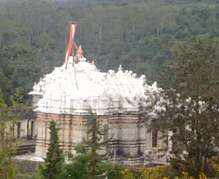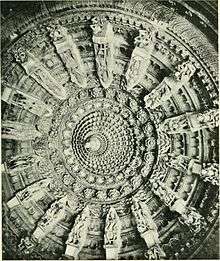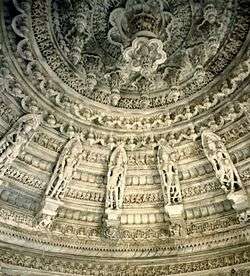Dilwara Temples
The Dilwara Temples or Delvada Temples are located about 2 1⁄2 kilometres from the Mount Abu settlement, Rajasthan's only hill station. These Jain temples were built by Vimal Shah and designed by Vastupala, Jain minister of Dholka, between the 11th and 16th centuries and are famous for their use of white marble and intricate marble carvings.[1] They are a pilgrimage place of the Jains, and a popular general tourist attraction. Although Jains built many temples at other places in Rajasthan, the Dilwara temples are believed to be the most impressive.[2][3]
| Dilwara temples | |
|---|---|
દેલવાડાનાં જિનમંદિરો | |
 Vimal Vasahi Temple | |
| Religion | |
| Affiliation | Jainism |
| Deity | Rishabhanatha, Neminatha, Parshvanatha & Mahavira |
| Festivals | Mahavir Janma Kalyanak, Paryushan |
| Governing body | Seth Kalyanji Paramanandji Pedi |
| Location | |
| Location | Mount Abu, Sirohi, Rajasthan, India |
 Location within Rajasthan | |
| Geographic coordinates | 24°36′33.5″N 72°43′23″E |
| Architecture | |
| Creator | Vimal Shah, Vastupala-Tejpal |
| Date established | 1031 AD |
| Completed | 1582 AD |
| Temple(s) | 5 Śvētāmbar & 1 Digambar |
| Part of a series on |
| Jainism |
|---|
 |
|
Jain prayers |
|
Ethics |
|
Major sects |
|
Texts |
|
Festivals
|
|
|
Architecture
The temples have an opulent entranceway, the simplicity in architecture reflecting Jain values like honesty and frugality.[4] The ornamental detail spreading over the minutely carved ceilings, doorways, pillars, and panels is considered to be remarkable.[5] It is said that workmen were paid in gold according to the weight of marble powder scraped off.[6]
Five Temples
The temple complex is in the midst of a range of forested hills. There are five temples in all, each with its own unique identity.[7] All the five temples are enclosed within a single high walled compound. The group is named after the small village of Dilwara or Delvara in which they are located. The five temples are:
- Vimal Vasahi, dedicated to the first Jain Tirthankara, Shri Adinatha
- Luna Vasahi, dedicated to the 22nd Jain Tirthankara, Shri Neminatha.
- Pittalhar, dedicated to the first Jain Tirthankar, Shri Adinatha.
- Parshvanath, dedicated to the 23rd Jain Tirthankara, Shri Parshvanatha.
- Mahavir Swami, dedicated to the last Jain Tirthankara, Shri Mahaviraswami.
Among all the five legendary marble temples of Dilwara, the most famous of those are the Vimal Vasahi and the Luna Vasahi temples.[8][9]
Vimal Vasahi Temple
The Adinatha or Vimala Vasahi Temple is carved entirely out of white marble and was built in 1031 A.D. by Vimal Shah, a minister of Bhima I, the Chaulukya king of Gujarat. The temple is dedicated to Lord Rishabha.[10][11] The temple stands in an open courtyard surrounded by a corridor, which has numerous cells containing smaller idols of the tirthankaras. The richly carved corridors, pillars, arches, and 'mandaps' or porticoes of the temple are simply amazing.[12]
The ceilings feature engraved designs of lotus-buds, petals, flowers and scenes from Jain mythology.[13] The figures of animal life, life journey from dream to incarnation of tirthankars are carved.[14][15] There are 59 devakulikas(small shrine) facing the main image of Rishabhanatha. There are 7 additional cells are found, 1 cell houses image of Ambaji and 2 cells of Munisuvrata.[16] The mulnayak idol of Rishabhanatha is finally carved with attendant deities and images of 4 tirthankar carved, giving the idol name Saparikar Panchtirthi.[17]
The Navchowki is a collection of nine rectangular ceilings, each containing beautiful carvings of different designs supported on ornate pillars. The Gudh mandap is a simple hall after stepping inside its heavily decorated doorway. The Gudh mandap, houses two idols of Parshvanatha in Kayotsarga position.[18] Installed is the idol of Adi Nath or Lord Rishabdev, as he is also known. The mandap is meant for Aarti to the deity. The ceiling has carvings of horses, elephants, musician, dancers and soldier.[19]
The Hastishala (Elephant courtyard) was constructed by Prithvipal, a descendant of Vimal Shah in 1147-49 and features a row of elephants in sculpture with the members of the family riding them.[20]
Luna Vasahi

The Luna Vasahi or Neminatha temple is dedicated to Lord Neminath. This magnificent temple was built in 1230 by two Porwad brothers - Vastupal and Tejpal - both ministers of a Virdhaval, the Vaghela ruler of Gujarat.[11] The temple built in memory of Vastupal & Tejpal's late brother Lunig was designed after the Vimal Vashi temple. The temple has a similar structure as Vimala Vasahi but rich with extraordinary sculptural decoration.[21] The main hall or Rang mandap features a central dome from which hangs a big ornamental pendant featuring elaborate carving. Arranged in a circular band are 72 figures of Tirthankars in sitting posture and just below this band are 360 small figures of Jain monks in another circular band.[22] The Hathishala or elephant cell features 10 beautiful marble elephants neatly polished and realistically modelled. One of the special feature of temple is the two niches of Derani(wife of younger brother) and Jethani(wife of older brother), the wife of Vastupal and Tejpal.[23] Both of the niches has the image of Goddess Lakshmi with sculpture of Sambhavanatha and Shantinatha respectively.[24]
The Navchowki features some of the most magnificent and delicate marble stone cutting work of the temple. Each of the nine ceilings here seems to exceed the others in beauty and grace. The ceilings of the temple depicts scenes of the life of Neminatha with image of Rajmathi (who was to marry Neminatha)[25] and Krishna.[26][27] The Gudh mandap features a black marble idol of the 22nd Tirthankara Neminatha. The Kirthi Stambha is a big black stone pillar that stands on the left side of the temple. The carvings of devkulikas and Chakreshvari in the ceiling of temple is also noteworthy.[28][29] The Kirti Stambha(pillar of pride) was constructed by Maharana Kumbha of Mewar.[30] The remaining three temples of Dilwara are smaller but just as elegant as the other two.
Pittalhar Temple

This temple was built by Bhima Shah, a minister of Sultan Begada of Ahmedabad, between 1316-1432 AD.[31][32] A massive metal statue of the first Tirthankara, Rishabha Dev (Adinath), cast in five metals, is installed in the temple. The main metal used in this statue is 'Pital' (brass), hence the name 'Pittalhar'.[33][34] The name of the temple is also mentioned in an inscription dating back to 1432, found in Digambar shrine in Dilwara complex.[35]
There are a total of 107 images in the main shrine.[31] The Shrine consists of a main Garbhagriha, Gudh mandap and Navchowki with idol of yakshi Chakreshvari and yaksha Gomukha on both sides.[36] It seems that the construction of Rangmandap and the corridor was left unfinished. The old mutilated idol was replaced and installed in 1468-69 AD weighing 108 maunds (four metric tons) according to the inscription on it.[37] The image was cast by an artist 'Deta' which is 8 ft (2.4 m). high, 5.5 ft (1.7 m). broad and the figure is 41 inches (1,000 mm) in height.[31] In Gudh Mandap on one side, a big marble Panch-Tirthi sculpture of Adinath is installed. Some shrines (devakulika) were constructed in 1474 and 1490, before construction was abandoned.
Shri Parshvanatha Temple
.jpg)
This temple, dedicated to Lord Parshvanath, was built by Sangvi Mandlik and his family in 1458–59.[34] According to popular belief, masons offered free remaining stones of Vimala Vasahi and Luna Vasahi to add the marble since the temple was built by grey stone.[38] It consists of a three-story building, the tallest of all the shrines at Dilwara. On all the four faces of the sanctum on the ground floor are four big mandaps housing a Choumukha idol of Parshvanatha.[39] On the first floor, the Chaumukha idol the front iconography is of Chintamani Parshvanath, second Magalakar Parshvanatha and third Manoratha-Kalpadruma Parshvanatha all are depicted with hood of 9 cobra. The image of fourth image of Parshvanatha is illegible.[40] In the corridor there are images of 17 tirthankaras and paintings of flowers. There is depiction of 14 dreams of mother of tirthankar has before birth.[40] On the second floor, the Chaumukha idol is of Sumatinatha, Parshvanatha, Adinatha and Parshvanatha. The idol of Goddess Ambika is also present. On the third floor, the Chaumukha idol is of Parshvanatha.[41]
The outer walls of the sanctum comprise beautiful sculptures in gray sandstone, depicting Dikpals, Vidhyadevis, Yakshinis, Shalabhanjikas and other decorative sculptures comparable to the ones in Khajuraho and Konark.[33]
Shri Mahaveer Swami Temple
This is a small structure constructed in 1582 and dedicated to Lord Mahavira.[16] Being small it is a marvelous temple with carvings on its walls. On the upper walls of the porch there are pictures painted in 1764 by the artists of Sirohi. There are detailed carvings of flowers, pigeons, court-scene, dancing girls, horses, elephant, and other scenes. On each side of Mahavira, there are 3 idols of tirthankar.[42] Outside the shrine, there is a marble slab of rectangular shape with a triangle stone over it containing 133 images of miniature-sized tirthankar with a larger image in center.[16]
Jirnoddhar (Repairs)
The temples have undergone repairs time to time. Allauddin Khilji had attacked and damaged the temples in 1311. In 1321, Bijag and Lalag of Mandore had undertaken repairs.
In 1906, Lallubhai Jaichand of Patan had the temples repaired and reconsecrated on April 25, 1906, under the supervision of Yati Hemasagar.[43] Extensive repairs were again undertaken during 1950-1965 by Anandji Kalyanji with the work done by the Sompura firm Amritlal Mulshankar Trivedi.[44] The older marble has a yellow patina, whereas the newer marble is white.
The temples are currently administered by the Seth Kalyanji Paramanandji Pedi (not to be confused by Seth Anandji Kalyanji Pedhi of Ahmedabad).[45] Seth Kalyanji Paramanandji Pedi also runs a Bhojanshala (dining hall) nearby.
Amenities
Facilities are available for bathing, which is mandatory before puja is performed for the idols. These facilities use passive solar power to heat up the water for bathing and other things. Guided tour hours for tourists are posted outside the temple.
Gallery
 Jethani shrine in Luna Vasahi
Jethani shrine in Luna Vasahi Carving of Devkulikas on ceiling of Luna Vasahi
Carving of Devkulikas on ceiling of Luna Vasahi Jain Derasar, Mt.Abu
Jain Derasar, Mt.Abu Interior of the Luna Vasahi or Shri Neminath Temple, Dilwara
Interior of the Luna Vasahi or Shri Neminath Temple, Dilwara Dilwara Temple, domed ceiling, detail
Dilwara Temple, domed ceiling, detail.jpg) Dilwara in 1990
Dilwara in 1990- Dilwara Temple ceiling detail
 Doorway detail
Doorway detail Kalpavriksha illustration in Dilwara Jain Temple
Kalpavriksha illustration in Dilwara Jain Temple
See also
References
Citation
- Shah 1995, p. 17.
- Adams 1864, p. 127.
- White 1996, p. 410.
- Kumar 2001, p. 9.
- Watson 1873, p. 32.
- Tobias 1991, p. 78.
- Coolidge 1880, p. 149.
- Balfour 1885, p. 948.
- Kumar 2001, p. 67.
- Dundas 2002, p. 221.
- Subramanian 2003, p. 105.
- Gupta 2003, p. 45.
- Mehta 1970, p. 18.
- Mehta 1970, p. 20.
- Tobias 1991, p. 79.
- Mehta 1970, p. 17.
- Mehta 1970, p. 29.
- Mehta 1970, p. 28.
- Dalal 2010, p. 409.
- Mehta 1970, p. 33.
- Topsfield 2014, p. 61.
- Mehta 1970, p. 40.
- Mehta 1970, p. 37.
- Mehta 1970, p. 39.
- Shah 1987, p. 169.
- Titze & Bruhn 1998, p. 253.
- Shah 1987, p. 165.
- Shah 1987, p. 175.
- Shah 1987, p. 229.
- Mehta 1970, p. 49.
- Mehta 1970, p. 51.
- Delwada Jain Temples - Mt. Abu, Muni Jayantvijay Ji, Pub. Seth Kalyanji Paramanandji Pedi, p. 16
- Dalal 2010, p. 106.
- Titze & Bruhn 1998, p. 158.
- Mehta 1970, p. 50.
- Shah 1987, p. 227.
- Stott & McCulloch 2014, p. 128.
- Mehta 1970, pp. 52-53.
- Forlong 2005, p. 10.
- Mehta 1970, p. 53.
- Mehta 1970, p. 54.
- Mehta 1970, p. 16.
- Delvada Pratishtha Mahotsava, Jain Conference herald, May 1906, p. 133
- Delwada Jain Temples - Mt. Abu, Muni Jayantvijay Ji, Pub. Seth Kalyanji Paramanandji Pedi, p. 4
- Mehta 1970, p. 14.
Sources
- Subramanian, V. K. (2003), Art Shrines of Ancient India, Abhinav Publications, ISBN 9788170174318
- Kumar, Sehdev (2001), A Thousand Petalled Lotus: Jain Temples of Rajasthan : Architecture & Iconography, Abhinav Publications, ISBN 9788170173489
- Dalal, Roshen (2010), The Religions of India: A Concise Guide to Nine Major Faiths, Penguin Books India, ISBN 9780143415176
- Stott, David; McCulloch, Victoria (2014), Rajasthan, Delhi & Agra, Footprint Travel Guides, ISBN 9781909268395
- White, David Gordon (1996), The Alchemical Body: Siddha Traditions in Medieval India, University of Chicago Press, ISBN 9780226894973
- Shah, Umakant Premanand (1987), Jaina-rūpa-maṇḍana: Jaina iconography, Abhinav Publications, ISBN 81-7017-208-X
- Topsfield, Andrew (2014), In the Realm of Gods and Kings, Philip Wilson Publishers, ISBN 9781781300145
- Mehta, Jodh Sinha (1970), Abu to Udapiur, Motilal Banarsidass
- Shah, Umakant Premanand (1995), Studies in Jaina Art and Iconography and Allied Subjects, Abhinav Publications, ISBN 9788170173168
- Titze, Kurt; Bruhn, Klaus (1998). Jainism: A Pictorial Guide to the Religion of Non-Violence. Motilal Banarsidass. ISBN 978-81-208-1534-6.
- Coolidge, Archibald Cary (1880), The Rajputana Gazetteer, 3, Government Central Branch Press.
- Kumar, Sehdev (2001), A Thousand Petalled Lotus: Jain Temples of Rajasthan : Architecture & Iconography, Abhinav Publications, ISBN 9788170173489
- Gupta, Shobhna (2003), Monuments of India, Har-Anand Publications, ISBN 9788124109267
- Forlong, James George Roche (2005), Encyclopaedia of religions, Genesis Publishing Pvt Ltd, ISBN 9788130700823
- Adams, W. J. (1864), Bradshaw's hand-book to the Bombay presidency and North-western provinces of India, Oxford University
- Balfour, Edward (1885), The Cyclopædia of India and of Eastern and Southern Asia, 1, B. Quartitc
- Dundas, Paul (2002) [1992], The Jains (Second ed.), London and New York: Routledge, ISBN 978-0-415-26605-5
- Tobias, Michael (1991), Life Force: The World of Jainism, Jain Publishing Company, ISBN 9780875730806
- Watson, John F. (1873), Vienna Universal Exhibition 1873. A Classified and Descriptive Catalogue of the Indian Department, Allen, ISBN 9788182053922
External links
| Wikimedia Commons has media related to Dilwara Temples. |
- Dilwara -A Legendary Marble Temple
- The Delwara Temples at Mount Abu Jaina Architecture in India, ch.1
